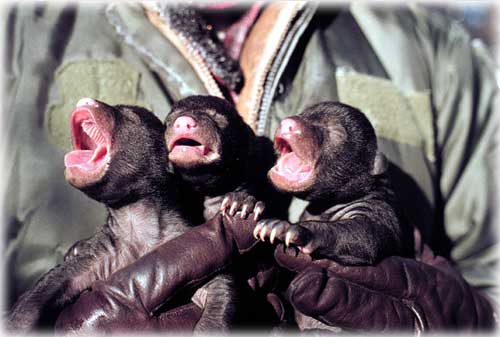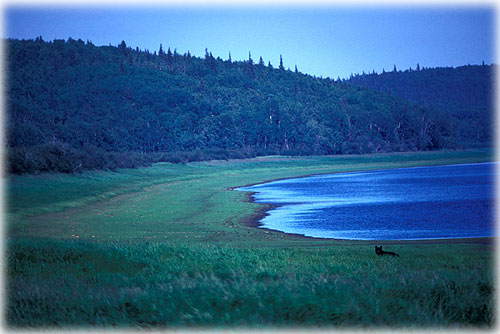 By Ned Rozell April 11, 2007
You somehow sense that it's time for a change. Perhaps prompting you is the persistent sunlight that strikes the snow covering your den. Maybe meltwater collecting in your nest-like bed wakes you, and reminds you of how uncomfortable you are. Whatever the reason, you nose toward the light and paw at the framework of twigs you pulled over the entrance to the den months ago.  black bear cubs in the Yukon Flats National Wildlife Refuge. Photo by Mark Bertram, courtesy the U.S. Fish & Wildlife Service.
You pull yourself skyward, creating a tunnel of snow and earth that is a little more than a foot wide. Sluggish, you stand on four stiff legs, feeling the warmth of the sun for the first time in half a year. If you are a healthy bear, you are one of the first to emerge from the den. Less healthy, skinnier bears come out next, followed by mother bears with cubs. Tiny, woolly cubs, born in January and early February, weigh a few pounds each. You stumble into spring air and sunshine. Walking hurts your feet; you shed your callused footpads from the previous year, and the new skin needs toughening. Seeing a dry spot under a nearby spruce tree, you lightfoot over and plop down like a tired dog. Your body slowly reacts to the small amount of activity you've just performed. You feel the need to use functions that were shut down during the last half-year. For example, you haven't urinated or defecated since entering the den in late September. While you were curled up, your liver and kidneys recycled your urine. Your kidneys have filtered your blood of impurities, which are normally released as urine. While hibernating, however, your urine was reabsorbed back into your bloodstream. The urine flowed to your liver, which converted it to useful amino acids.  Photo courtesy the U.S. Fish & Wildlife Service.
When the greens are available, your diet will consist almost entirely of vegetation, which will serve to jump-start your digestive system. Later, in perhaps a week, your nose will lead you to a smelly salmon carcass you missed in the fall. You wander from the den site, following your nose to other prizes. You fill your belly. The sun shines. It's a great time not to be hibernating in Alaska. You are no longer a bear. You are a person, reading a newspaper column, which I wrote with bear facts and speculations from Mark Bertram, a U.S. Fish and Wildlife Service wildlife biologist; Erich Follmann, a professor of zoology at the University of Alaska Fairbanks' Institute of Arctic Biology; and Don Young, a biologist with the Alaska Department of Fish and Game in Fairbanks.
Publish A Letter on SitNews Read Letters/Opinions
|